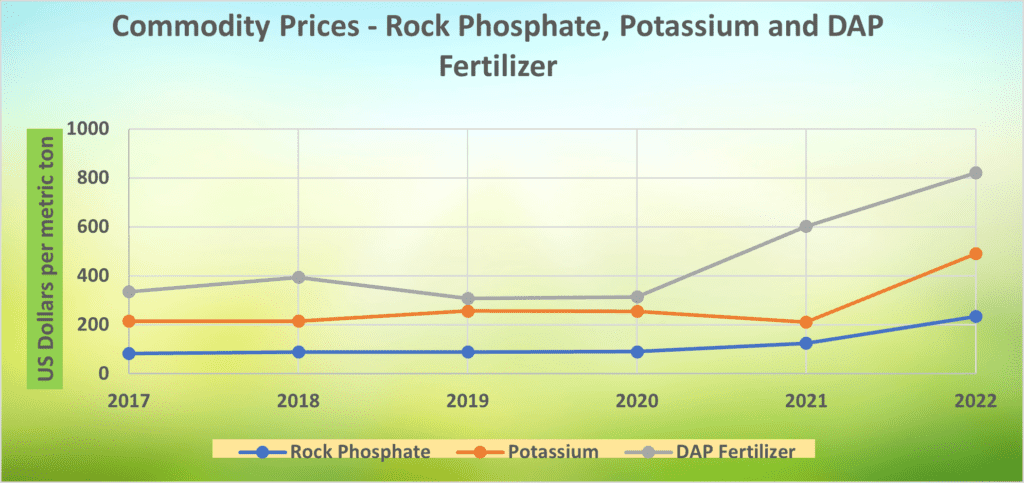Fertilizer is a significant farm input that is crucial to ensure the healthy growth of crops, plants, and trees. As discussed before, farm inputs mean all the resources that are required in the process of crop production. Apart from fertilizers, farm inputs also include seeds, water, labor, machinery, and fuel. Currently, the economy is witnessing a surge in the prices of food as the cost of farm inputs has risen for the farmers. This includes a sudden hike in the prices of fertilizers too. As fertilizer is one such input that farmers have no alternative to, the rise in the price of this will keep impacting the consumers directly.
Fertilizer plays a crucial role in the process of food production. It is needed to provide additional nutrients to the crops so that they can grow properly. As plants and crops are necessary for the sustainability of all lifeforms on Earth, they must be provided with all the care.
All plants need 17 essential elements to grow to their full genetic capacity. Of these 17, 14 are absorbed by plants through the soil, while the remaining three come from the air and water. Nitrogen, Phosphorus, and Potassium, or NPK, are the “Big 3” primary nutrients in commercial fertilizers. Each of these fundamental nutrients plays a key role in plant nutrition.
- Nitrogen (N): Plants need nitrogen the most because it is the essential element in the formation of proteins. Protein helps in tissue formation and growth of plants.
- Phosphorus (P): Another useful element for plants and crops is Phosphorus. It helps in the process of photosynthesis. The productivity of crops directly depends upon the rate of photosynthesis. It provides oxygen in the atmosphere for all living organisms. Photosynthesis also maintains a balanced level of oxygen and carbon dioxide in the ecosystem. Phosphorus is extracted from phosphorus rock and then blended into fertilizers.
- Potassium (K): Potassium is also one of the key nutrients. It helps in building the plant’s ability to resist disease. It also protects the plants from extreme weather. This nutrient is essential to increase a crop’s yielding capacity and improve its overall quality.

Reasons for Hike in the Cost of Fertilizers Russia and Ukraine are amongst the most important agricultural producers in the world and export large quantities of fertilizers around the globe. Although supply from Russia to other countries has not stopped, disruptions caused by economic sanctions (Belarus and Russia), and export restrictions (China) are the main reasons for the lack of supply and increase in the prices of fertilizers. High fertilizer demand recorded higher price levels since the beginning of the pandemic and geopolitical risks also triggered the prices of fertilizers as shown in the above chart.
American farmers are struggling with the high cost of production due to continuous hikes in prices of all farm inputs, including fertilizers. However, it is essential to note that farmers are not just struggling with an increase in fertilizer prices, but the availability of fertilizers and other inputs is also posing a challenge. The most recent Ag Economy Barometer from Purdue University found that nearly 40% of farmers had some difficulty purchasing inputs for the 2022 season.
Demand for Fertilizer for Corn and Soybeans
High prices of fertilizers and other farm inputs will impact the production of soybeans and corn. These are the most demanding crops all over the world. Corn and soybeans are both highly valued crops with many buyers as both are used for many purposes including food for animals and humans. They are an excellent source of fiber and energy. As a large producer of corn, soybeans, and wheat, the U.S. is also a large consumer of fertilizer. The U.S. is the third-largest producer of fertilizer globally. However, the country still requires the importation of all three nutrients (NPK), especially nitrogen and potassium, to fully meet the demand. Therefore, U.S. fertilizer dealers and U.S. producers are required to pay the price defined by the global market for fertilizer and fertilizer materials, plus their transportation costs.
It is predicted that farmers will face much higher fertilizer prices, beginning in the 2023 planning season and it is expected that farmers who will purchase fertilizers in 2023 will see a much higher cost than what they paid in the year 2021.
By Prashansha Yadav
